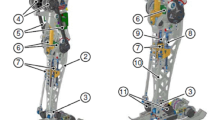Abstract
Robots that are capable of learning new tasks from humans need the ability to transform gathered abstract task knowledge into their own representation and dimensionality. New task knowledge that has been collected e.g. with Programming by Demonstration approaches by observing a human does not a-priori contain any robot-specific knowledge and actions, and is defined in the workspace of the human demonstrator. This article presents a new approach for mapping abstract human-centered task knowledge to a robot execution system based on the target system properties. Therefore the required background knowledge about the target system is examined and defined explicitly.
Similar content being viewed by others
References
Dillmann, R., Rogalla, O., Ehrenmann, M., Zöllner, R., Bordegoni, M.: Learning robot behaviour and skills based on human demonstration and advice: the machine learning paradigm. In: 9th International Symposium of Robotics Research (ISRR 1999), pp. 229–238. Snowbird, Utah, USA, (1999) October
Schaal, S.: Is imitation learning the rout to humanoid robots?. In: Trends in Cognitive Sciences, vol. 3, pp. 233–242 (1999)
Calinon, S., Billard, A.: Learning of gestures by imitation in a humanoid robot. In: Dautenhahn, K., Nehaniv, C. (eds.) Imitation and Social Learning in Robots, Humans and Animals: Behavioural, Social and Communicative Dimensions, Cambridge University Press (2005)
Alissandriakis, A., Nehaniv, C., Dautenhahn, K., Saunders, J.: Using jabberwocky to achieve corresponding effects: imitating in context across multiple plattforms. In: Proc. of Workshop an the Social Mechanisms of Robot Programming by Demonstration at ICRA 2005 (2005)
Sato, Y., Bernardin, K., Kimura, H., Ikeuchi, K.: Task analysis based on observing handds and objects by vision. IEEE/RSJ Int. Conf. on Intelligent Robots and Systems, Lausanne, pp. 1208–1213 (2002)
Kuniyoshi, Y., Inaba, M., Inoue, H.: Learning by watching: extracting reusable task knowledge from visual observation of human performance. IEEE Trans. Robot. Autom. 10(6), 799–822 (1994)
Zoellner, R., Pardowitz, M., Knoop, S., Dillmann, R.: Towards cognitive robots: building hierarchical task representations of manipulations from human demonstration. Intl. Conf. on Robotics and Automation (ICRA) 2005, pp. 1535–1540. Barcelona, Spain (2005)
Chen, J., Zelinsky, A.: Programming by demonstration: coping with suboptimal teaching actions. Int. J. Rob. Res. 22(5), 299–319 (2003), May
Nicolescu, M., Mataric, M.: Natural methods for robot task learning: instructive demonstrations, generalization and practice. In: 2nd International Joint Conference on Autonomous Agents and Multiagent Systems, 2003, pp. 241–248. Melbourne, Australia (2003) July
Konolige, K., Myers, K.L., Ruspini, E.H., Saffiotti, A.: The Saphira architecture: a design for autonomy. J. Exp. Theor. Artif. Intell.: JETAI 9(1), pp. 215–235 (1997). Available online: citeseer.ist.psu.edu/konolige97saphira.html
Firby, R.J.: The RAP language manual, version 2. I/NET Inc., Tech. Rep. (2001)
Firby, R.: Adaptive execution in complex dynamic worlds. Ph.D. dissertation, Yale University, Computer Science Department (1989)
Hager, G., Peterson, J., Hudak, P.: A language for declarative robotic programming. In: Proceedings of the International Conference on Robotics and Automation, pp. 1144–1151 (1999)
Simmons, R., Apfelbaum, D.: A task description language for robot control. In: Proceedings of the Conference on Intelligent Robots and Systems (IROS) (1998)
Erol, K., Hendler, J., Nau, D.S.: HTN planning: complexity and expressivity. In: Proceedings of the Twelfth National Conference on Artificial Intelligence (AAAI-94), vol. 2., pp. 1123–1128. Seattle, Washington, USA: AAAI Press/MIT Press. Available online: http://citeseer.ist.psu.edu/24780.html (1994)
Erol, K., Hendler, J., Nau, D.: Semantics for HTN planning. Computer Science Dept., University of Maryland, Tech. Rep. CS-TR-3239. Available online: http://citeseer.ist.psu.edu/erol94semantics.html (1994)
Myers, K.L.: A procedural knowledge approach to task-level control. In: Drabble, B. (ed.) In: Proceedings of the 3rd International Conference on Artificial Intelligence Planning Systems (AIPS-96), pp. 158–165. AAAI Press (1996)
Jensen, B., Froidevaux, G., Greppin, X., Lorotte, A., Mayor, L., Meisser, M., Ramel, G., Siegwart, R.: The interactive autonomous mobile system robox. In: Proceedings of the 2002 IEEE/RSJ Intl. Conference on Intelligent Robots and Systems. IEEE, pp. 1221–1227. ePFL, Lausanne, Switzerland (2002)
Knoop, S., S. Schmidt-Rohr, R., Dillmann, R.: A flexible task knowledge representation for service robots. In: The 9th International Conference on Intelligent Autonomous Systems (IAS-9), Kashiwa New Campus, The University of Tokyo, Tokyo, Japan, (2006) 7 March
Ehrenmann, M., Zöllner, R., Rogalla, O., Vacek, S., Dillmann, R.: Observation in programming by demonstration: training and exection environment. In: Humanoids 2003, Karlsruhe/Munich, Germany, October 2003 (2003)
Pardowitz, M., Zöllner, R., Dillmann, R.: Learning sequential constratins of tasks from user demonstrations. In: Proc. IEEE-RAS Intl. Conf. on Humanoid Robots (HUMANOIDS), pp. 424–429. Tsukuba, Japan (2005)
Andersen, H.-C.: Generierung von ausführbaren roboterprogrammen aus makrooperatoren. Master Thesis, Universität Karlsruhe (TH), (2005) Oktober
Nehaniv, C.L., Dautenhahn, K.: The correspondence problem in social learning: what does it mean for behaviors to match anyway?. Perspectives on imitation: From cognitive neuroscience to social science. Available online: citeseer.ist.psu.edu/603394.html (2002)
Kang, S.: Robot instruction by human demonstration. Ph.D. dissertation, Carnegie Mellon University, Pittsburg, Pennsylvania (1994)
Arbib, M., Iberall, T., Lyons, D., Linscheid, R.: Hand Function and Neocortex. Goodwin, A., Darian-Smith, T. (Hrsg.): Springer-Verlag, ch. Coordinated control programs for movement of the hand, pp. 111–129 (1985)
Author information
Authors and Affiliations
Corresponding author
Rights and permissions
About this article
Cite this article
Knoop, S., Pardowitz, M. & Dillmann, R. From Abstract Task Knowledge to Executable Robot Programs. J Intell Robot Syst 52, 343–362 (2008). https://doi.org/10.1007/s10846-008-9221-x
Accepted:
Published:
Issue Date:
DOI: https://doi.org/10.1007/s10846-008-9221-x




